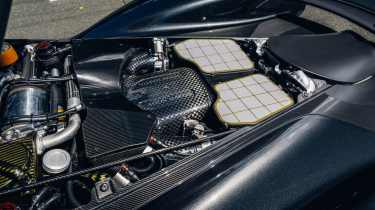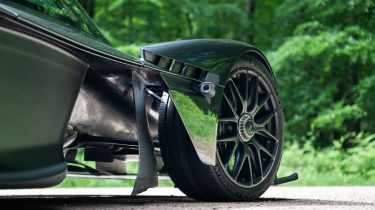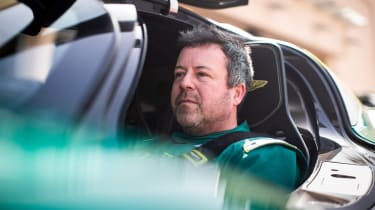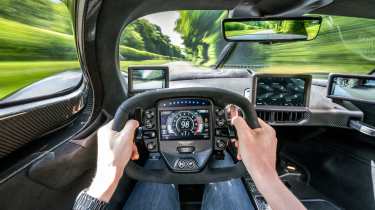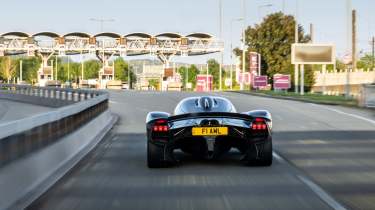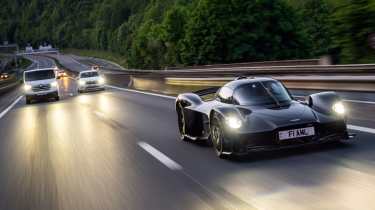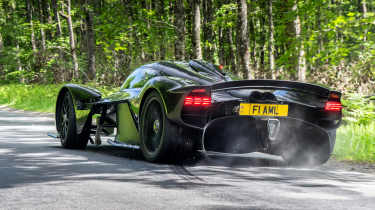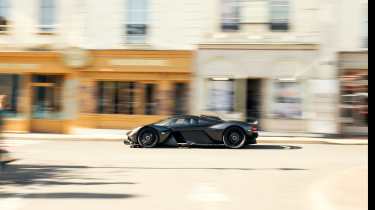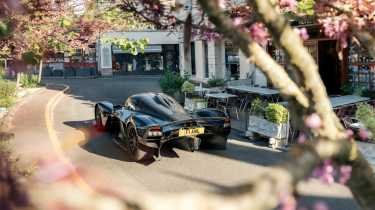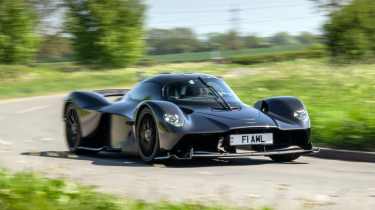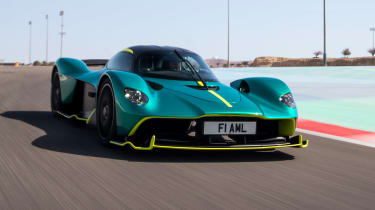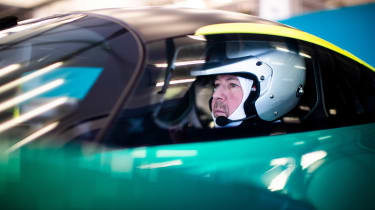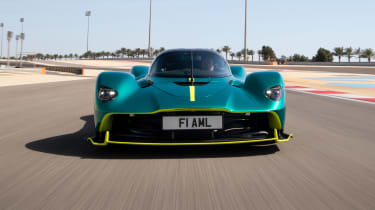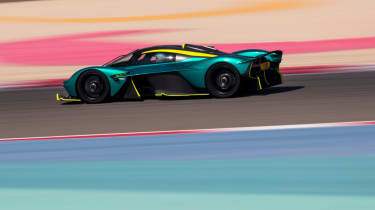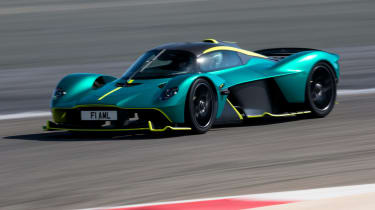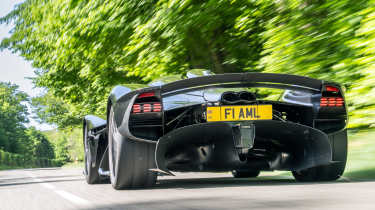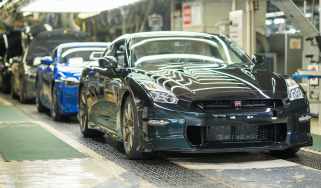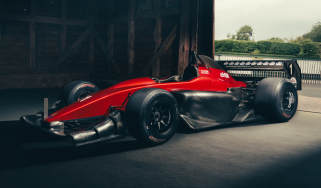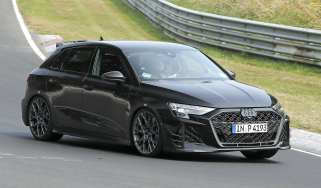Aston Martin Valkyrie 2025 review – 700 miles in the world's most extreme hypercar
Aston’s Newey-designed hypercar astonishes on road and track, but is it the best thing ever to wear number plates, or too uncompromising for its own good?
Valkyrie. The car we feared we’d never drive. Yet here we are, with a drive around the Bahrain International Circuit and a 700-mile road trip from Silverstone to Le Mans from which to draw our conclusions on one of the most extreme road-legal hypercars we will likely ever see.
Whether you’re remotely fond of Aston Martin, or simply seduced by the insanity of attempting to build and homologate Adrian Newey’s vision for the ultimate road-legal hypercar, getting behind the wheel of a Valkyrie is a momentous occasion.
Such has been its turbulent genesis, troubled financing and tortured gestation the Valkyrie’s plug could surely have been pulled countless times. Few cars have endured such a protracted and at times humiliating development, fewer still conducted under such public scrutiny. Still, if it was easy everyone would be doing it. Right? That literally nobody was doing it should probably have been enough of a clue to deter Aston Martin from committing to such a moonshot, but in AML’s defence the prospect of Newey-designed high-downforce, high-revving, hybrid hypercar was utterly mouth-watering.
And rightly so, for not since the McLaren F1 had we been treated to the prospect of a car that would re-write the rules of road-legal performance. Yes, there has been the Bugatti Veyron, but where Ferdinand Piech’s vision was a rocket sled blessed with the temperament of a VW Golf, the Valkyrie was Newey’s chance to take all his Grand Prix-winning genius and refract it through a road-going hypercar prism. For Aston, it was an irresistible opportunity to reach for the stars.
More reviews
To truly understand the Valkyrie you need to unpack its constituent parts. Unfortunately, to do so you need to be an engineer with a planet-sized brain. The words to adequately describe what lies beneath the Valkyrie’s bodywork (and indeed why its bodywork is shaped the way it is) could fill a book. Handily, Aston Martin has produced just that – the 336-page ‘A Wild Ride – The Making of Valkyrie’ by Bart Lenaerts. It’s surprisingly candid and well worth a look.
It's no secret the relationship between AML and Red Bull became increasingly fractious as the irresistible force (Newey) met the immovable object (budget constraints and the realities of road homologation). In many ways this creative friction was the essence of Valkyrie, but as the programme progressed so the full scale of the undertaking became monolithic. It wasn’t so much a learning curve as a sheer rock face.
Some of the stories are already the stuff of legend: that one of the supplier companies bought so much titanium the MoD rang to check they weren’t involved in arms supply; that the composite windscreen wiper was developed by a NASA supplier; that the 40-microns-high etched titanium badge has to be refrigerated before being applied.
Working on Valkyrie might well have been a once-in-a-career opportunity, but there’s a reason why those hardy souls who’ve seen it through have put themselves through a real-life ageing app.
Seeing the Valkyrie parked, whether in the Bahrain pitlane or the queue for the Eurotunnel, the pain of those punchy meetings and apparently impossible challenges was worth every drop of blood, sweat and tears. It’s a sensationally small and svelte machine, with smooth, organic body panels forming an insectile exoskeleton that simultaneously works and cheats the air like no car before it. Beneath the body sit gargantuan underfloor venturi tunnels that create an alien, mantis-like stance. It really is a breathtaking piece of work. One that obeys the functional demands of Newey’s punishing aero targets yet satisfies Aston’s desire for sculptural form.
Packaging-wise it’s as extreme as it gets. Open the engine cover and it all-but bursts open like an over-filled holiday suitcase. The capsule-shaped cockpit is equally shrink-wrapped. Not long after the first interior buck was first shown Aston’s then-CEO Andy Palmer famously said both he and Chief Creative Officer, 6’4” Marek Reichman, could sit next to one another comfortably. How much baby oil was required to get them in (or indeed out) wasn’t disclosed. All I’ll say is climbing in requires a technique otherwise known only to drivers of Le Mans prototypes.
Once in, the driving position doesn’t feel as extreme as you might imagine. Yes, your feet are higher than your hips, but the semi-foetal position is comfortable, with your body entirely supported from shoulders to calves. The seat is fixed – each Valkyrie has the driver’s seat tailored to its owner – but the pedals can be adjusted fore and aft. There’s also adjustment in the steering wheel, so after a bit of fenagling you can get yourself settled into an ‘elbows-in’ race driver tuck. It’s unconventional, but unmatched for occasion.
Bringing the Valkyrie to life is simple. Just prod the steering wheel-mounted ‘Engine Start/Stop’ button twice to wake-up the various layers of electronics, then hold the brake and press again to start the engine. The promise of what 1155PS and 11,100rpm holds in store is ample distraction from the dirge sound at idle, but there’s no denying the industrial nature of the cockpit soundtrack is both intrusive and disappointing.
Thanks to assistance from the e-motor pulling away from a standstill is a cinch. It’s all very smooth, which is just as well because your first run in the Valkyrie is pretty intimidating. The value and straight-line performance are daunting, but the nerves are mostly because the aerodynamics and active suspension are a huge leap compared to anything that has come before.
700 miles in the Aston Martin Valkyrie on the road – James Taylor
On the dual-carriageways out of Silverstone, the Valkyrie feels as out of place amid the surrounding vans, lorries and SUVs as a UFO landing at Heathrow. It’s a curious feeling to ignore the signs for Silverstone Circuit, driving away from the racetrack that former Aston CEO Andy Palmer said the Valkyrie would lap as quick as an F1 car, and instead aim for the M25 and the Dartford Crossing. Paradoxically, a journey like this is a tougher test for the Valkyrie than a Grand Prix circuit, and a bigger adventure. If a potentially masochistic one.
On the move, however, the Valkyrie is a genuinely user-friendly car to drive. Docile, even. Despite having so much power on tap, the engine is anything but peaky. At lower revs, its large capacity gives it a torquey, easy-going feel. With linear naturally aspirated response combined with a long-travel throttle pedal, power and torque delivery are beautifully precise and it’s easy to trundle around at regular road speeds.
The seven-speed gearbox is a motorsport-style dog-box (the engine is too high-revving for synchromesh) yet, aided by the e-motor, it can slur through up- and downshifts almost as smoothly as an auto ’box. It won’t upshift automatically, but if you forget to downshift, on the way into a roundabout for example, it can change down through the gears autonomously to spare your blushes. The gearshift paddles are immensely satisfying to use, magnetised for the snappiest, most tactile response. They’re part of a bespoke carbonfibre steering wheel that has a screen at its centre giving you essential information, supplemented by a touchscreen mid-dash for air-con and further displays. It’s a little clunky to use but if you’re buying an Aston Martin Valkyrie for its infotainment, you’re doing it wrong.
There are no mirrors in the Valkyrie. The ‘wing mirrors’ are tiny, wind-cheating cameras on stalks feeding two small screens bookending the dashboard. Since there’s a solid bulkhead behind you, there’s a central rear-view camera too (plus a second, invaluable, parking camera). The displays’ frame rate is speedy enough that they soon feel natural.
The active suspension, too, is saloon-car smooth. It combines its pushrod-operated dampers with hydraulically actuated torsion bars, constantly working to keep a consistent ride height for the aerodynamics, and also to counter roll and pitch. There are anti-roll bars, but much of the resistance comes from the active system. The Valkyrie adjusts its torsion bars to react to the aero load, but the system also allows it to get down the road in a supple, fluid way.
Apart from the volume (I try taking one earphone off, gasp and cram it back over my lug as quickly as I can), the vibration and the sheer other-worldliness of the Valkyrie as an entity, it’s a relatively calm car to drive.
When you’re moving in fresh air rather than snarled up in traffic jams and towns, that is. Low-speed driving is the Valkyrie’s weak point. Like many racing-derived cars, the turning circle is enormous. A three-point turn’s more likely to be a seven-point turn. And since the air-con system is occasionally required to cool elements of the tightly packaged powertrain, it occasionally blows hot air into the cabin. With no windows to wind down, I pull over before we reach the M25 and change into shorts.
The hybrid system integrates the electric motor (which also does the job of starter, alternator and reverse gear) into the transmission and feeds it from a Rimac-supplied 1.8kWh battery. Since the battery’s small, it rapidly runs low when manoeuvring at parking and traffic jam speeds. If it drops below, say, 60 per cent charge, there’s a chance it won’t be able to restart the engine. At which point technicians would need to get involved. You need to keep the engine running for a little while to top up the battery before switching off if you’ve been driving slowly. Something I need to bear in mind when driving onto LeShuttle shortly. It’s going to be a noisy train carriage for a little while before I can silence the V12.
Then there’s the sheer attention the Valkyrie gets. I’ve never known a car that generates as big a stir as this. On the M25, it’s difficult to change lane, not because people are being deliberately obstructive but because they’re driving alongside trying to get a better look, often while wielding a smartphone. Traffic ahead begins to weave drunkenly in its lane, as drivers’ eyes are pulled to their mirrors more than the road ahead.
Early morning is a special time to be driving the Valkyrie. The cabin is cool, not yet warmed by sun nor mechanicals. The urban roads are relatively quiet, not yet filled by commuters nor holiday-makers. It’s a surreal tableau to be sharing the streets with a few careworn people-carriers, ageing vans and even the odd Mehari buggy as we make our way to the autoroute.
The motorway is scantly trafficked too, and on an empty, well-sighted stretch, I open the Valkyrie’s throttle in a consequential way for the first time. It’s the first of two moments that redefine my understanding of the Valkyrie and what it can do. The pedal’s travel is long enough that your ankle’s muscle memory initially pauses at the point where full throttle would be in most cars. The Valkyrie is already accelerating with an intensity that’s difficult to put into words. It takes genuine conviction to keep pushing, past the 10,500rpm at which peak power is generated, and to illuminate the blue shift-lights on the steering wheel.
What moments ago was a vanishing point on the horizon is now an awful lot closer. It’s a momentary snapshot of the Valkyrie’s potential but it’s pivotal. Nothing’s quite the same now. The goalposts have moved.
The Valkyrie’s top speed is limited to 224mph, because that’s the maximum rating for its wheel-speed sensors, and its gear ratios are set accordingly. Without the limit, and with longer gearing, its theoretical top speed would be far north of 250mph, perhaps much more. ‘As quick as you want in theory,’ Dunn says, ‘because the active aero can dial out the drag. It’s a very slippery car.’
But straight lines are one thing, and not what the Valkyrie was designed for. Its core purpose is lap time; in fact, it’s multiple seconds a lap faster than a slick-shod GT3 racing car. If we were to enter the car we’re driving into qualifying for this year’s 24 Hours of Le Mans, it could qualify halfway up the grid on its road-legal Michelins. The Valkyrie sits on 20- and 21-inch Cup 2s, as fitted to the Porsche 992 GT3 RS. They take a little warming up and the car squirms around roundabouts at urban speeds until they gain temperature. At speed, though, its active aerodynamic surfaces are so clever that they develop maximum downforce up until the tyres are at maximum load, then actively bleed it back, ensuring the tyres are squidged as firmly into the tarmac as possible without overstepping their rating at any speed.
We’re on the autoroute for now. It’s possible to listen to music or podcasts via Bluetooth to your phone, or internet radio via the touchscreen, though you’ll need to crank the volume up at motorway speeds. You’re more likely to be using the screen to keep an eye on the coolant and oil temperatures, and the level of charge in the battery. And the fuel level. I’ll lose count of the number of times we stop for fuel between Silverstone and Le Mans. It’s a thirsty car.
But it shouldn’t be a surprise that such an uncompromising design means a few compromises, to the extent that Newey wasn’t keen on fitting a front numberplate plinth, theorising customers would replace the plate with a sticker. After some debate, Aston Martin won the battle to fit a plinth. Ironically, in simulation, the Valkyrie produced even more front downforce with the numberplate in place than before. Which goes to show that aerodynamics is the most unpredictable of dark arts.
In the countrysinde we find ourselves amid a patchwork quilt of fields draped over gently rolling hills, without a soul in sight. Finally, the Valkyrie can stretch its legs a little. And this is the second moment that redefines my understanding of what this car, indeed what a hypercar in general, can do. It’s intense – very – but also oddly calm. The steering is rapid in response – you need barely a flex of your wrists to introduce the car to a corner – yet measured, and beautifully insulated from bumps and cambers.
You feel them, but they don’t corrupt the steering. The active suspension is the same. I’d expected the Valkyrie to feel a bit of a fish out of water on a road like this, too firm and too low, but it soaks up the most dilapidated of surfaces, and mid-corner lumps and ridges never throw it off course. Yet we’re riding low enough for the aerodynamic channels beneath the car to be engaged. In the ‘mirrors’, I can see a rooster-tail of dust high in the air. There are three driving modes: Urban, Sport and Track. In the last of those, the car sinks even further on its suspension and the dusty rooster-tail gets taller, but it still works on the road.
And it’s still so driveable. That’s the thing that really surprises me: despite the car’s apparently limitless abilities, you don’t feel like ballast, like an operator simply turning the wheel and pressing the pedals. It gives you back what you put into it. It’s like some kind of magic blend between a Caterham and a Le Mans prototype (and I intend that as a sincere compliment). It feels narrower than most conventional supercars too, so you can pick your own line through a corner and use more of the road.
There’s lovely feel through the surprisingly long-travel brake pedal. The pedals are set up so that you can brake with your left or right foot, and it quickly feels natural to left-foot brake right up to an apex. As you blend out of the brakes with your left foot, you’re already feeding in the V12 with your right. It feels like it wants to rev to the moon. Torque is limited slightly in the lower gears and there’s a fair bit of traction control activity. It’s not until you’re in fourth gear that the Valkyrie really gets into its stride.
At which point it’s probably best to stop for a breather. You can drive the Valkyrie as fast or as slow as you wish, but the former demands some self-restraint. The need to fill up with fuel, again, and make it to our overnight stop means it’s time to rejoin the main route. But that drive will stay with me for a long time.
Tantalisingly, we can’t turn any laps of Circuit de la Sarth: the track is being prepared for the race, overalled workers painstakingly painting the blue and yellow kerbs. But we have the empty start-finish straight and Dunlop bridge to ourselves. The sense of atmosphere is off the scale.
And the sense of fatigue. I won’t pretend the entire journey was a breeze. Breaking the fourth wall for a moment, shooting a video and a magazine feature meant a lot of turning around and driving up and down the same bits of road umpteen times. The Valkyrie is a time-consuming car to volte-face, and not being able to dip off the road onto grass or gravel for fear of damaging the aerodynamic floor meant sometimes driving several kilometres further down the road to find a safe turning spot. And every time you stop, you have an audience. No matter how remote the location, 30 phone-wielding people magically appear the moment you pull up.
So limited is the fuel range, it’s almost like planning a journey in an electric car. Twice, while photographing in remote places, we topped up the tank from a jerry can, just in case. The lowest fuel economy figure on the trip computer was 4mpg, the highest 19mpg.
The car needed one brief reset, when it wouldn’t engage first gear from neutral on one occasion. A couple of times the mirror cameras briefly went on the blink. Oh, and while stuck in a lengthy traffic jam, the rear numberplate’s adhesive melted from exhaust heat. But otherwise it genuinely was trouble-free. And, since we haven’t driven the most direct route, and there was plenty of looping back and forth for the cameras, we’ve covered around 700 miles in total.
Yes, it’s uncompromising, but at the same time the fact it can be driven on the M25 in rush hour, get over speedbumps and through a McDonald’s drive-thru, yet can lap a circuit faster than most racing cars of any category, makes it a machine of genuine bandwidth. But the biggest takeaway for me is how involving and exhilarating it is to drive on a country road. It turns out that what makes the Valkyrie extraordinary on a circuit also makes it extraordinary on a B-road.
Driving the Aston Martin Valkyrie on track – Richard Meaden
It might wear Pilot Cup 2 Michelins and ‘V12 AML’ registration plates, but the feeling you get as you trundle down the pit lane is pure race car. First impressions are very encouraging if somewhat overwhelming. The powertrain is a force of nature from the first squeeze of the throttle. We tend to fixate on the Cosworth-developed V12’s elevated redline, but while it’s most definitely a screamer it also displaces a whopping 6.5-litres. Augmented by a Rimac-developed hybrid system, there’s slingshot torque whenever you need it.
In the first few gears you can sense the Pilot Cup 2s are wincing a bit, but the electronics nip wheelspin in the bud until those venturis start sucking the Valkyrie to the tarmac. On the plus-side the steering has satisfying weight and brilliantly measured rate of response, so despite the tension in your arms the steering is just calm enough to smooth the rough edges from your inputs. It means you quickly settle into guiding the Valkyrie towards the first few corners rather than nervously nibbling and nudging it towards an apex. The brake pedal is firm, but not rock-hard in the manner of a pure race car, so much like the steering there’s some progression and travel to help dial-in your pedal effort. For such an alien craft the basics feel remarkably intuitive.
I’ve been fortunate to drive some high-downforce competition cars in the past, none mightier than Porsche’s 919 Hybrid racer. Driving the Valkyrie is reminiscent of the LMP1 car because the first thing you get to grips with its straight-line performance, followed by the braking, with committed cornering coming only once you’ve built a degree of familiarity and trust in the machine and yourself.
The speed the Valkyrie gains between corners is of another magnitude to any road car I’ve ever driven on track. The combination of hybrid-assisted shove as you exit the corner and that searing top-end rush as you push to 11000rpm and beyond is insanely intense. For the first few laps it takes a concerted effort to explore the full rev range. Using 9000rpm feels more than ample, but when you commit to winding each gear through to the shift lights you really do access another realm. One that’s equal parts awe, exhilaration and slight unease.
It's not the raw acceleration that has your brain buffering – though the way it devours gears is pretty extraordinary – but the speed at which you approach the braking zones. The Alcon/Surface Transforms brakes have epic stopping power, but thanks to the active aero you also get a huge increase in downforce under hard deceleration. It takes a very deep breath to fully commit, but the results are genuinely eye-popping.
The most vivid demonstration of this comes at the end of Bahrain’s start-finish straight. Approached in 7th gear with the throttle pinned wide open, the Valkyrie is doing a true 200mph. Being an F1 circuit the brake marker boards only start at 150m. Even the Valkyrie can’t live with that kind of braking distance, but we’ve been told to imagine there’s a 200m board and hit the brakes there.
I won’t pretend the sensation is entirely comfortable, but the adrenaline buzz you get having successfully slowed the car and made the corner really does take some beating. It’s the bit in between that’s somewhat masochistic, for it requires you to ignore the increasingly desperate cries of your brain telling you to ‘brake-brake-BRAAAAKE!’ before finally mashing the left-hand pedal and batting down through the gears as Turn 1 snap zooms into focus.
At first everything feels like it’s happening too fast, but the trick is to look further and further ahead. It feels unnatural, but it’s all part of the recalibration process. One that you gradually get on top of lap-by-lap, but with less time to relax on the straights and so much compressed into each braking effort the Valkyrie is a ruthless and relentless test of your focus and mental stamina.
Predictably the toughest aspect of getting to grips with the Valkyrie is understanding the active suspension and downforce, then learning to trust the electronics which underpin it. For Newey, extreme aero and active suspension always went hand-in-hand, as it was the only way he could maintain a consistent ride height and therefore a stable aerodynamic platform during track use, while preserving the pliancy necessary for the Valkyrie to work on the road.
His solution combines regular springs and dampers with a torsion bar system actuated by powerful hydraulics, which serve to actively manipulate the suspension’s pre-load. This works to counter the vertical loadings generated by the aerodynamics and also give the Valkyrie active anti-squat, anti-roll and anti-dive.
The beauty of the active system is that by reacting to real-time loadings rather than simply being subjected to them as in a passively suspended car, the support (stiffness) is proportionate and only there when its needed. However, because it reacts to dynamic loadings there’s a fractional degree of latency in the system’s response. In order to mitigate this the engineers at Red Bull Advanced Technologies mapped the Valkyrie’s dynamic envelope to create a feed-forward control strategy, which is handled by a dedicated ACU (Active Control Unit). In laymen terms, not only does the Valkyrie know what it’s doing at any given time, but based on the initial driver input it has a very good idea of what will happen next. It’s still reacting, but the system’s ‘thinking’ time is significantly reduced. Clever stuff indeed.
Where the really clever stuff happens is in controlling the amount of compliance the suspension has during cornering and under braking and acceleration. At its most effective an active suspension system would remain flat as a board, but this would render it completely numb in terms of driver feedback. To provide the driver with sensory cues the Valkyrie’s active suspension has been tuned to yield by a small amount while maintaining a far higher degree of body control than a passive car.
As you’d expect the Valkyrie is at its flattest and most tied-down in Track mode, so while there’s some perceptible initial movement as the car is subjected to accelerative, decelerative or lateral loads, it’s only for a fleeting moment before the torsion bars do their thing and the platform is stabilised. This makes it tough to feel how hard you’re working the chassis because the sensation of leaning into the available grip or traction is fleeting and finite.
An added Valkyrie-specific challenge is gauging when car is working with mechanical grip alone, and when the aerodynamics take over. This is fundamental to how confidently you can power out of a low-speed corner, peel into a series of increasingly fast direction changes or brake from high speed into an awkwardly angled low-speed apex.
In slower corners it’s easy enough to decode what’s happening on the way in or the way out and react accordingly. You need to be especially mindful of how much torque you’re asking the rear tyres to transmit before the aero makes a meaningful difference, similarly how much braking force can be absorbed. In each instance there are electronic systems to rely on – you can feel the TC intervene, ESC is very hard to detect and ABS is really only there to stop a lightly loaded inside front wheel from grabbing in the final phase if you try and brake too hard and too deep into an apex.
It’s in higher speed corners a greater leap of faith is required because you don’t have the explicit, analogue reference points to draw from. It’s also clear the 20in front and 21in rear Michelin Cup 2’s (N-rated Porsche items) are working in a realm they are not entirely comfortable, so even if you do trust in the aero you still sense the tyre is struggling to cope. You certainly don’t get the utterly outrageous feeling of limitless grip that comes from the combination of slicks and wings.
Cup R’s – not available when Valkyrie design started – would undoubtedly make a significant difference, but Aston engineers say they’d only be good for a few laps before wilting under the strain. It’s a real conundrum. One that must have been apparent from the moment the Valkyrie’s design brief pointed to road-legal tyres with acceptable wet weather properties having to deal with crushing downforce figures when driven on a racetrack.
As it stands, in order to protect its tyres the Valkyrie bleeds-off downforce. Under power this means not exceeding a sustained peak of more than 600kg. That figure rises to 1100kg during braking events from VMAX down to 220kph. It’s a long way from the 1800kg originally touted soon after the Valkyrie was made public, but despite this – and the inexorable creep from a projected dry weight of 1100kg to an official 1270kg – the Valkyrie remains a remarkable achievement and a uniquely intense driving experience.
Paradoxically, Newey’s complex and uncompromising vision was probably always destined to be significantly compromised. That it will take time, skill and considerable mental application to master is more a statement than a criticism, and a process that will surely bring great satisfaction to Valkyrie customers who crave new challenges and need a car with performance and personality that sets it apart from the others in their possession.
The horrendous cockpit noise is a major problem for the Valkyrie as a road car. Not least because a supercar’s soundtrack is a major selling point and source of pleasure, and also because driving while wearing a noise-cancelling headset deprives you of vital sensory connection.
Whether the Valkyrie will ever assume its place alongside the McLaren F1 as one of the truly seminal supercars is a question everyone would like answered, but one nobody can definitively offer. It certainly has all the ingredients, most obviously the touch of a Grand Prix design genius. It even has its own set of flaws to match the McLaren’s weak brakes and lack of roll stiffness.
You really become a part of this car when you drive it, in every sense. The noise and the heat and the vibration that travels throughout the chassis also travels through you, and I’m not sure my hearing will ever be quite the same again. But you’re immersed in a truly remarkable machine.
Price and rivals
The Valkyrie’s production run, of 150 coupes, 85 Spiders and 40 AMR Pro track-only versions, sold out. That despite a price of around £2.5m for the coupe. Even so, reports suggest it was a challenge for Aston Martin to make a profit.
The AMG One is an obvious competitor, but its well-documented struggles with reliability are of major concern. Perhaps the closest in terms of pedigree and appeal is the GMA T.50, which applies his own genius to the task of creating the ultimate high-downforce hypercar. When we get this pair together it will be a test for the ages.
Aston Martin Valkyrie specs
| Engine | V12, 6500cc, plus 105kW electric motor |
| Power | 1139bhp @ 10,600rpm |
| Torque | 681lb ft @ 7000rpm |
| Weight | 1270kg (dry) |
| Power-to-weight | 911bhp/ton (dry) |
| 0-60mph | <3.0sec |
| Top speed | 220mph (limited) |
| Basic price | £2.5 million |
| evo rating | 4 stars |
